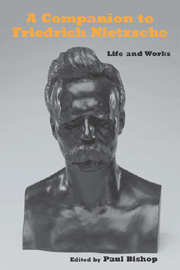Book contents
- Frontmatter
- Contents
- Acknowledgments
- A Note on Editions and Abbreviations
- Introduction
- Link to Nietzsche's Early Writings
- Link to The Birth of Tragedy
- Link to Untimely Meditations
- Link to Human, All Too Human
- Link to Daybreak
- Link to The Gay Science
- 6 The Gay Science
- Link to Zarathustra
- Link to Beyond Good and Evil
- Link to On the Genealogy of Morals
- Link to The Case of Wagner and Nietzsche contra Wagner
- Link to Twilight of the Idols, The Anti-Christ, and Ecce Homo
- Link to the Nachlass
- Conclusion
- Notes on the Contributors
- Index
6 - The Gay Science
from Link to The Gay Science
Published online by Cambridge University Press: 05 February 2013
- Frontmatter
- Contents
- Acknowledgments
- A Note on Editions and Abbreviations
- Introduction
- Link to Nietzsche's Early Writings
- Link to The Birth of Tragedy
- Link to Untimely Meditations
- Link to Human, All Too Human
- Link to Daybreak
- Link to The Gay Science
- 6 The Gay Science
- Link to Zarathustra
- Link to Beyond Good and Evil
- Link to On the Genealogy of Morals
- Link to The Case of Wagner and Nietzsche contra Wagner
- Link to Twilight of the Idols, The Anti-Christ, and Ecce Homo
- Link to the Nachlass
- Conclusion
- Notes on the Contributors
- Index
Summary
Introduction
The Gay Science (Die fröhliche Wissenschaft) was originally published in four parts or books, with a prelude in German rhymes in 1882; a fifth part, together with an appendix of songs and a preface, was added and published in 1887. Nietzsche began to compose notes for what would become The Gay Science in the summer of 1881, drafting a set of remarkable notes that have yet to be translated into English, many anchored around his experience of the thought of eternal recurrence. Nietzsche's initial plan was for an addition to his previously published book, Daybreak (Morgenröthe), and he conceived it as his last book. He wrote to his amanuensis Heinrich Köselitz, whom he called Peter Gast, at the end of January 1882 that he had recently completed books 6–8 of Daybreak, with the two final parts, books 9–10, to be reserved for the following winter because, as he put it, “I have not yet matured enough for the prime ideas which I shall present in these books” (ich bin noch nicht reif genug für die elementaren Gedanken, die ich in diesen Schluß-Büchern darstellen will; KSB 6, 159). In particular, Nietzsche confides that there is one idea that requires a “thousand years” to mature and that he needs the strength to express it: a clear reference to the doctrine of eternal recurrence. Approximately two weeks later, however, he reported to Gast that a draft of the new book was well in process.
- Type
- Chapter
- Information
- A Companion to Friedrich NietzscheLife and Works, pp. 167 - 192Publisher: Boydell & BrewerPrint publication year: 2012

